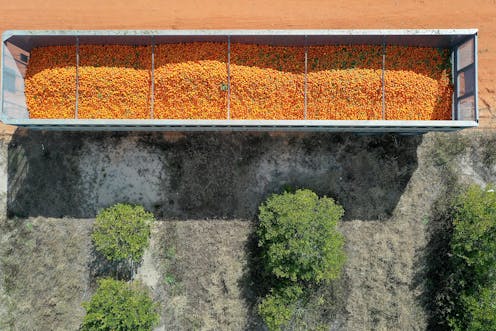
Citrus is still big business in Florida, but the industry has taken a massive hit in recent decades. Joe Raedle/via Getty Images
Citrus trees showing natural tolerance to citrus greening disease host bacteria that produce novel antimicrobials that can be used to fight off the disease, our recent study shows. We found the trees at an organic farm in Clermont, Florida.
Citrus greening disease – known more formally as Huanglongbing, or HLB, is caused by the bacterium Candidatus Liberibacter asiaticus. It is spread by an insect called the Asian citrus psyllid. There is no known cure for the disease.
We are Florida-based researchers who study sustainable farming practices, a discipline also known as agroecology. Our team has isolated these antimicrobial compounds in the lab and is now working to test them with the goal of producing an effective treatment for HLB.
Why it matters
HLB has dealt a massive blow to Florida’s iconic citrus industry.
Since citrus greening disease was first detected in the state in 2005, Florida citrus production is down by more than 92%. The disease is just one factor. Others include hurricanes and freezes.
Infected trees produce fewer fruit. The fruit that does grow is partially green, smaller, shaped irregularly and bitter tasting. It may drop from the trees before ripening. Leaves may show blotchy mottling.
According to the U.S. Department of Agriculture, the 2022-2023 growing season was the least productive since 1936. Smaller crops lead to higher prices on oranges, tangerines, grapefruits, lemons and limes.
Pomelo tree leaves with symptoms of citrus greening.
Conor Wolfe, CC BY-ND
Management of HLB is daunting. Growers currently rely on pesticides to control the psyllid and antibiotics like oxytetracycline in an attempt to control HLB. These treatments are expensive and may pose health and environmental risks. The need for development of effective treatments to control HLB is evident.
How we did our work
Like humans, plants host diverse communities of microorganisms both inside and outside, representing the plant microbiome.
Endophytes – beneficial microorganisms living inside plants – play an important role in nutrient intake, disease and pest resistance, and adaptation to environmental stress.
In a search for treatments against HLB, we looked to endophytes of survivor citrus trees – in other words, trees that are HLB positive but showed only mild symptoms and continue to bear fruit. By studying 342 endophytes of survivor trees, we discovered five bacterial endophytes capable of producing novel antimicrobials.
The HLB bacteria cannot be grown on laboratory culture media like agar or broth. So, we used live bacterial cells present in the ground tissue samples of infected psyllids to test the antimicrobial compounds in the lab. These studies revealed that the antimicrobial compounds were highly effective at killing the live cells of citrus greening pathogen in this controlled environment. The antimicrobials can be mixed with water and were found to be effective at low concentrations.
What’s still not known
Preliminary results from our ongoing work indicate that multiple antimicrobial compounds are present in the bacterial culture extract. This is a positive sign because the antimicrobial compounds may be found to attack pathogenic bacteria in several different ways. If that’s the case, it will help minimize the development of resistance in the same way a variety of antibiotics are useful to human doctors.
One of our next steps will be to evaluate selected compounds against HLB, using infected citrus roots under laboratory conditions and infected citrus plants under greenhouse conditions, to test whether the plants will absorb these antimicrobial compounds through their leaves or roots. This work will be conducted in collaboration with scientists from Texas A&M University and the University of Florida.
What’s next
Further research will focus on methods to increase the production of purified antimicrobial compound in order for it to be evaluated in the field. To help get the technology to growers faster, we may look for partnerships with interested commercial biopesticide companies to help with product development.
Our work has taken on new urgency due to emerging psyllid-transmitted diseases that infect potato, tomato and carrot crops in the U.S. that are caused by closely related bacterial pathogens.
The Research Brief is a short take on interesting academic work.
Kateel G. Shetty receives funding from USDA-NIFA Emergency Citrus Disease Research & Extension (ECDRE) program, grant number 2022-70029-38526
Jessica Dominguez received funding from USDA-NIFA-HSI Higher Education Grants Program (2016-38422-25549), USDA-NIFA-NNF (2021-38420-34074), USDA-NIFA-ECDRE program (2022-70029-38526), and financial support of FIU Doctoral Evidence Acquisition Fellowship to help fund her master’s and dissertation research at Florida International University.
Krishnaswamy Jayachandran receives funding from several USDA-NIFA programs – Hispanic Serving Institutions, National Needs Fellowship, Research Experience & Extension for Undergraduates, Beginning Farmers & Ranchers Development Program.
Advertisement

Advertisement
Contact Us
If you would like to place dofollow backlinks in our website or paid content reach out to info@qhubonews.com











